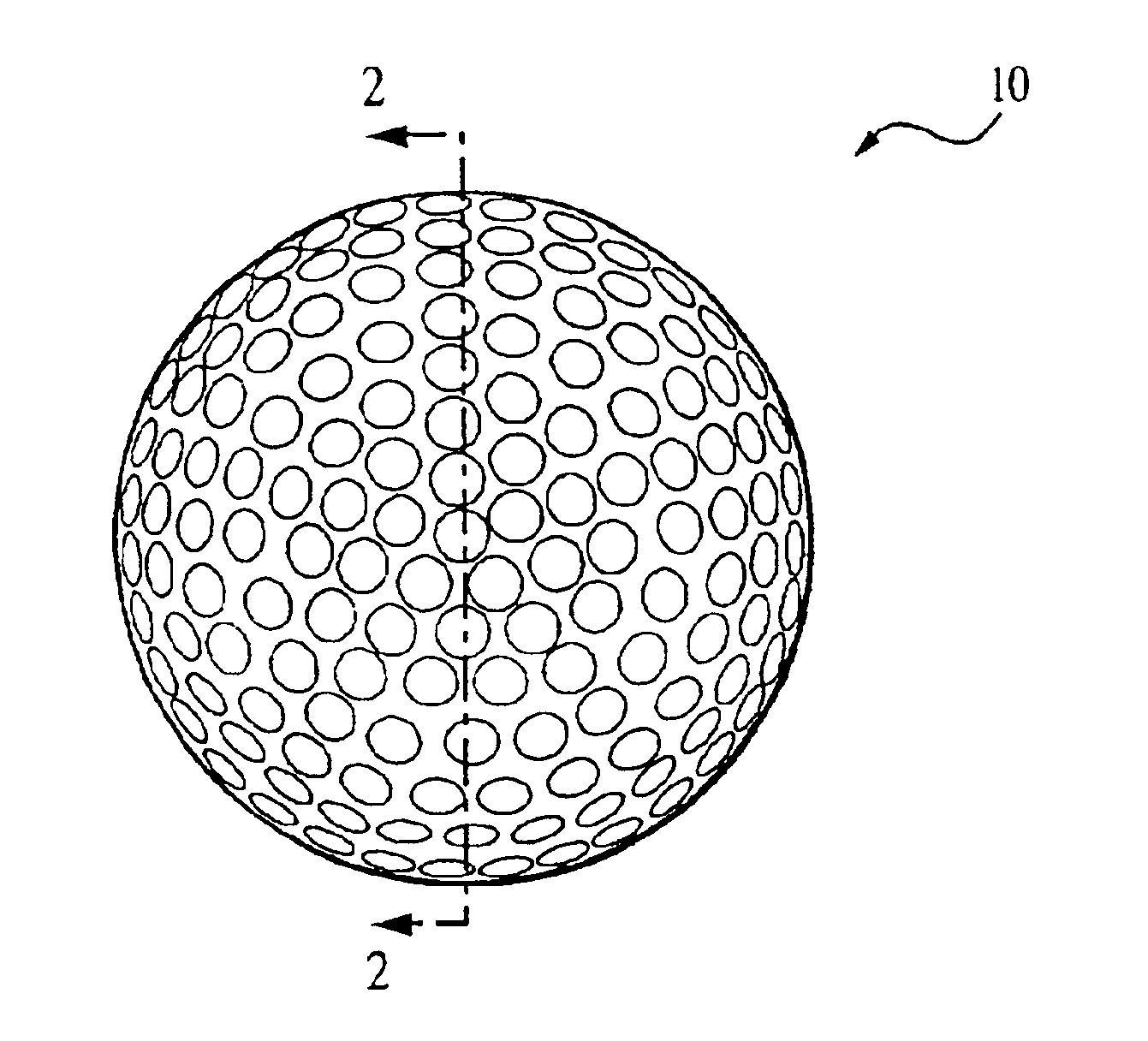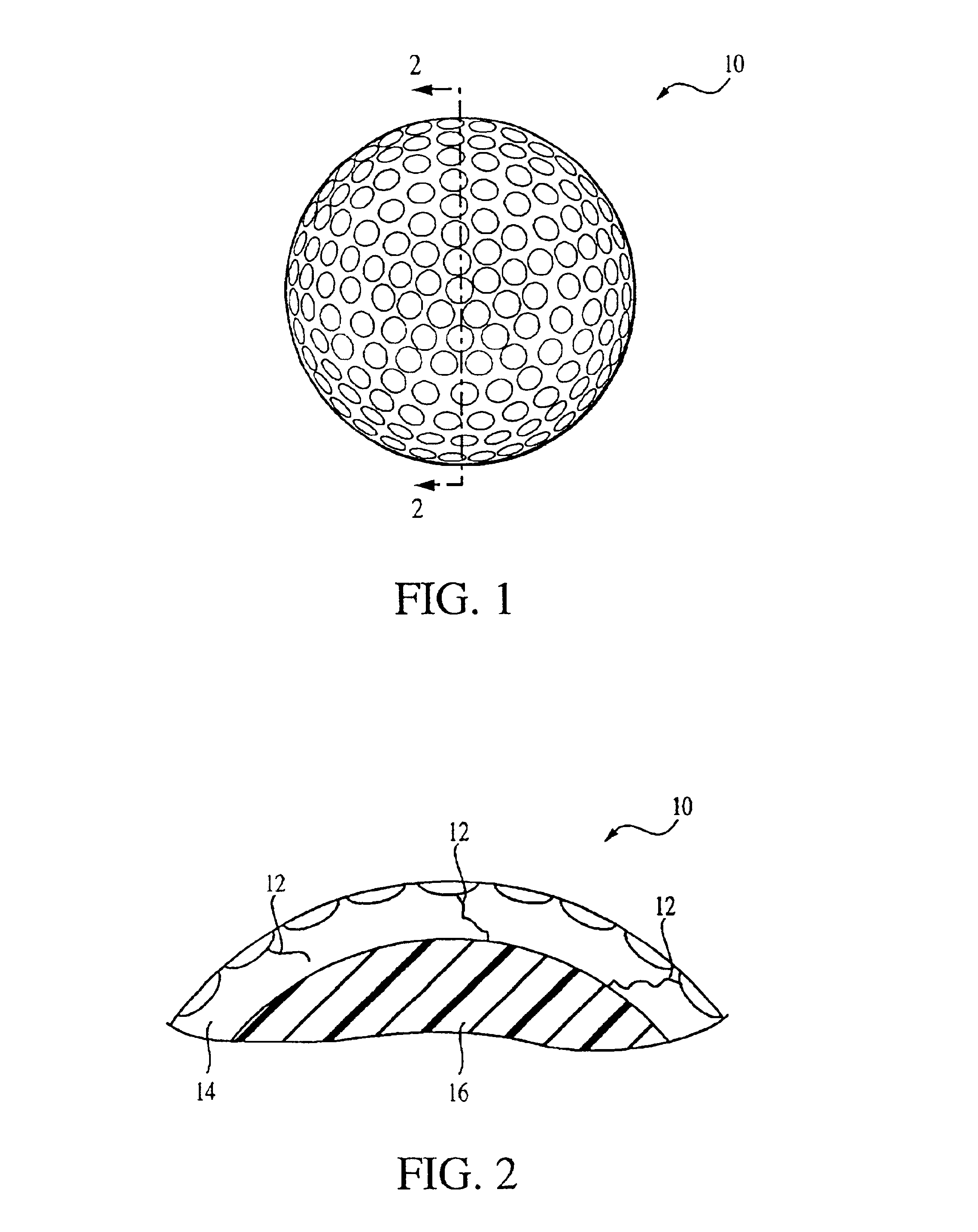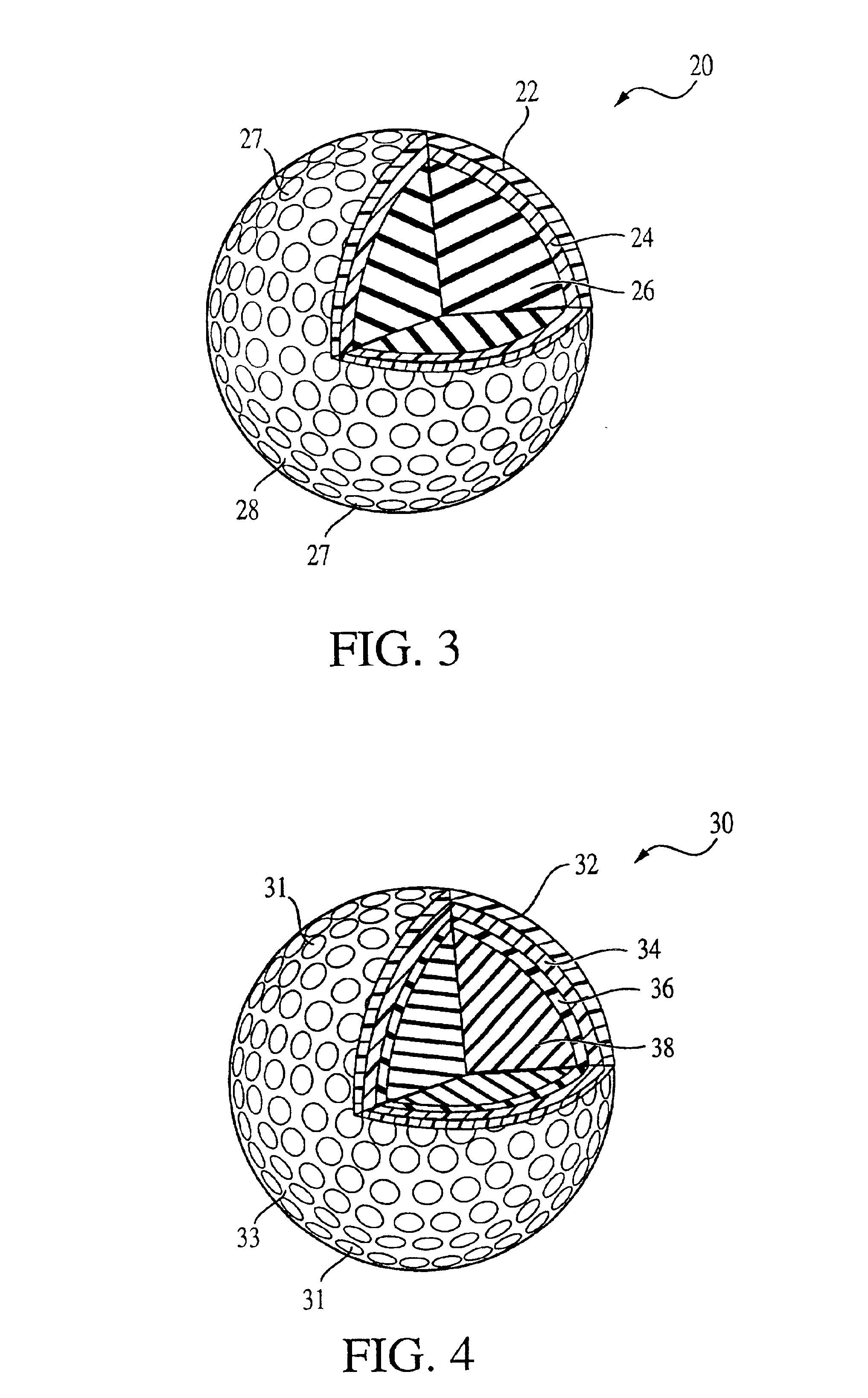Golf ball with multi-layer cover
a golf ball and multi-layer technology, applied in the field of golf balls, can solve the problems of golf ball cover cracking or fracture, golf ball performance impairment, and fractures across the thickness of the golf ball cover, and achieve the effect of improving durability
- Summary
- Abstract
- Description
- Claims
- Application Information
AI Technical Summary
Benefits of technology
Problems solved by technology
Method used
Image
Examples
example 1
Thick, Single Cover Oversize Balls
A number of golf ball cores having Formulation A, shown below, were prepared.
Core Formulation AParts byMaterialWeightSMR-CV 60125.00Taktene 220273.50Hi-Sil 234 LD36.00Zinc Oxide45.00Barytes #22580.00Stearic Acid61.60Agerite Superlite71.60TIO2 Rutile 202083.00Circolite Oil95.00Red pigment103.00Sulfur (insol)113.14Santocure N.S.121.28Methyl Zimate130.27D.P.G.140.68206.071Natural rubber, Muehlstein, Norwalk, CT 2Synthetic polybutadiene, Bayer Corp., Akron, OH 3Precipitated hydrated silica, PPG Industries, Pittsburgh, PA 4Zinc Corp. of America, Monaca, PA 5Harwick Chemical, Akron, OH 6Harwick Chemical, Akron, OH 7R.T. Vanderbilt, Norwalk, CT 8Harwick Chemical, Akron, OH 9Sun Oil, Philadelphia, PA 10Stauffer Chemical, Westport, CT 11Stauffer Chemical, Westport, CT 12R.T. Vanderbilt, Norwalk, CT 13R.T. Vanderbilt, Norwalk, CT 141,3-Diphenylguanidine (accelerator) R.T. Vanderbilt, Norwalk, CT
One to two dozen cores were made having an average diameter of 3...
example 2
Thick Covered Multi-Layer Golf Balls, Standard Size
A number of 32.8 mm (1.29 inch) average diameter golf ball cores were made using Core Formulation C, shown below. The curing process was the same as the sulfur curing process described above in Example 1. The cores were used to make four different types of golf balls having the cover compositions and thicknesses shown in Table 6 as Examples 2-1 to 2-4. The lotek 959 / 960 cover formulation (Cover Formulation X utilized) also is shown below.
Parts by WeightCore Formulation CCariflex BR 122080SMR CV 6020Zinc Oxide5Limestone110Stearic Acid1.6Agerite Superlite1.6Circolite Oil5Sulfur3.14Santocure N.S.1.28Methyl Zimate0.28D.P.G.0.68228.58Cover Formulation Xlotek 95945.3lotek 96045.3White MasterBatch9.4(see formulation in Ex. 1)
The resulting average PGA compression and coefficient of restitution of the golf balls also is shown in Table 6. A control example using a standard size, two piece ball core, i.e. 39.2 mm (1.545 inch) core, having Core...
example 3
Thick Covered Multi-Layer Balls, Standard Size
A number of sulfur-cured golf ball cores having an average diameter of 32.5 mm (1.28 inches) and the formulation shown below were formed:
Core Formulation DMaterialsphrCariflex BR-122080SMR CV-6020Zinc Oxide5Limestone20Stearic Acid1.6Circolite oil5Sulfur3.14Santocure N.S.1.28Methyl Zimate0.28D.P.G.0.68Agerite White10.81R.T. Vanderbilt, Norwalk, CT
The cores were cured for 12 minutes at 320° F., followed by cooling for six minutes with cooling water. The sulfur-cured cores (Examples 3-3, 3-4, 3-7 and 3-8) had an average surface Shore A hardness of 71, an average surface Shore C hardness of 35 and an average surface Shore D hardness of 21.
A number of peroxide-cured cores having an average diameter of 32.5 mm (1.28 inches) and Core Formulation B, shown above were formed. The cores were cured for 15 minutes at 310° F., followed by cooling for seven minutes using cooling water. The cores (Examples 3-1, 3-2, 3-5 and 3-6) had the PGA compression...
PUM
| Property | Measurement | Unit |
|---|---|---|
| thickness | aaaaa | aaaaa |
| diameter | aaaaa | aaaaa |
| diameter | aaaaa | aaaaa |
Abstract
Description
Claims
Application Information
 Login to View More
Login to View More - R&D
- Intellectual Property
- Life Sciences
- Materials
- Tech Scout
- Unparalleled Data Quality
- Higher Quality Content
- 60% Fewer Hallucinations
Browse by: Latest US Patents, China's latest patents, Technical Efficacy Thesaurus, Application Domain, Technology Topic, Popular Technical Reports.
© 2025 PatSnap. All rights reserved.Legal|Privacy policy|Modern Slavery Act Transparency Statement|Sitemap|About US| Contact US: help@patsnap.com



